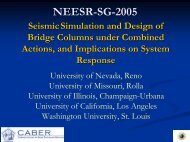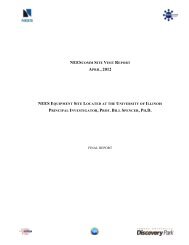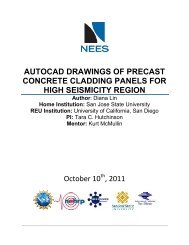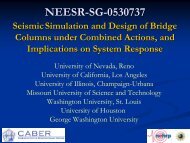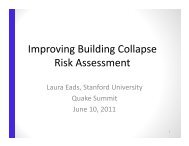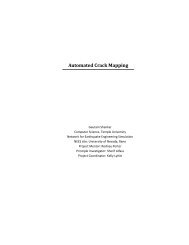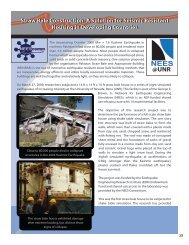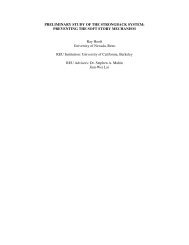TSUNAMI WAVE BREAKING BEHAVIOR ON A REEF WITH A ...
TSUNAMI WAVE BREAKING BEHAVIOR ON A REEF WITH A ...
TSUNAMI WAVE BREAKING BEHAVIOR ON A REEF WITH A ...
Create successful ePaper yourself
Turn your PDF publications into a flip-book with our unique Google optimized e-Paper software.
<strong>TSUNAMI</strong> <strong>WAVE</strong> <strong>BREAKING</strong> <strong>BEHAVIOR</strong> <strong>ON</strong> A <strong>REEF</strong> <strong>WITH</strong> A ROUGH SURFACE<br />
Kimberly J. Quesnel<br />
California Polytechnic State University, San Luis Obispo<br />
REU Institution: Oregon State University<br />
Principle Investigators: Dr. Ian Robertson, Dr. Ronald Riggs, Dr. Kwok Fai Cheung<br />
Graduate Student Advisor: Pablo Duarte Quiroga
1. Abstract<br />
This study is part of the University of Hawaii at Manoa’s HI<strong>REEF</strong> 2 project and aims to analyze the<br />
breaking behavior of tsunami waves over a reef shape similar to the ones present on tropical islands like<br />
Hawaii. In addition, energy dissipation due to bottom roughness was investigated and proven to be<br />
significant. When roughness was in the zone before breaking, waves were smaller, broke sooner, and<br />
crashed sooner than waves that propagated over roughness which had been placed after breaking.<br />
When looking at breaking characteristics in comparison to previous research where only a mild slope<br />
was considered, the waves in this experiment had a higher breaking index (wave height at<br />
breaking/water depth at breaking) and a lower water depth at breaking due to the geometry of the<br />
bottom surface, indicating that bathymetry plays a role in wave breaking. In the future, better<br />
understanding of the breaking behavior and energy dissipation of tsunami waves due to roughness and<br />
reef geometry will lead to more accurate numerical models that can then be used as engineering tools<br />
to save both infrastructure and lives in tsunami hazard zones.<br />
2. Introduction and Literature Review<br />
Tsunamis occur when underwater earthquakes, landslides, or volcanic eruptions create massive<br />
displacements of water that travel towards the shore at alarming speeds. When these massive waves<br />
reach the coastline, they are capable of causing enormous damage to infrastructure and killing<br />
thousands of people. It is crucial that we study tsunami events and wave propagation not only to<br />
improve our understanding of the phenomena, but so we can create improved building codes that can<br />
lead to enhancing human safety and improving our coastal management. The HI<strong>REEF</strong> 2 project is aimed<br />
at studying how tsunamis and structures are affected by bathymetry specific to the Hawaiian region and<br />
other islands. This particular part of the HI<strong>REEF</strong> project works to understand the effect of roughness and<br />
reef geometry on the breaking of these waves. By observing the wave breaking characteristics, the wave<br />
energy dissipation due to roughness and geometry can be estimated.<br />
Tsunamis are characterized by long wave lengths, and can<br />
therefore be simply modeled as solitary waves with<br />
theoretically infinite wavelengths (Young et al 2008). The<br />
hydrodynamic similarities between these two types of<br />
waves have been proven and solitary waves are therefore<br />
used in most experiments relating to tsunamis, including<br />
this one. This experiment differs from previously<br />
completed studies by Grilli et al. (1997) in that roughness is<br />
introduced by using timber planks installed in the bottom of<br />
the wave flume, as well as island reef bathymetry as seen by<br />
the steep slope and flat reef configuration of the tank.<br />
Figure 1: Bathymetry of the Hawaiian Islands.<br />
(SOEST, 2009)<br />
2
3. Methods<br />
3.1 Facility<br />
This experiment was carried out at the O.H. Hinsdale Wave Research Laboratory at Oregon State<br />
University in the Two-Dimensional Wave Flume (Figure 2). The tank measures 104m long by 3.7m wide<br />
by 4.6m deep, and a large stroke piston-type wavemaker is used to generate long wave tsunamis. The<br />
bottom of the flume is movable and therefore able to be configured in many different ways by placing<br />
concrete slabs at various depths and slopes along the tank. With the wavemaker as the datum (x=0), the<br />
bathymetry for this experiment was configured such that<br />
the first 28.6m was flat, the middle 25.6m was sloped<br />
upwards and the last 35.8m was again flat. The slope of the<br />
middle section remained at a constant 1:12 ratio<br />
throughout the entire duration of the HI<strong>REEF</strong> 2 project. This<br />
slope was considered to be steep as necessitated by the<br />
characteristics of a reef shape. Since tsunamis and reefs<br />
alike have a drastic range of sizes, it would be unreasonable<br />
to try to quantitatively scale the experiment in comparison<br />
to the real world. Therefore the project was not aimed at<br />
mimicking a particular tsunami at a specific location.<br />
Figure 2: Wave flume at the O.H. Hinsdale Wave<br />
Research Laboratory at Oregon State University.<br />
Figure 3: Diagram of wave flume and wave variables: water depth from tank bottom (ho), wave height from free surface<br />
(Ho), wave depth at breaking (hb), wave height at breaking from free surface (Hb), distance of breaking (db), distance of<br />
crashing (dc). The wavemaker location is represented by x=0.<br />
3
3.2 Instrumentation<br />
Instruments were used for this particular aspect of the project to<br />
determine the free surface profile of the water as a wave passed. Fourteen<br />
resistance-type parallel wire wave gauges and eight sonic wave gauges<br />
(Figure 4) recorded the height of the waves over time and were positioned<br />
down the length of the tank in the horizontal x-direction. The<br />
measurements from these instruments were used to record the actual<br />
wave height Ho and compare the values to the experimental Ho, the<br />
number that was entered into the wavemaker computer. The actual wave<br />
height values were typically 3-5% lower than the wave height input in the<br />
computer, and therefore the difference was not taken into account in this<br />
analysis.<br />
Figure 4: Wave measurement<br />
instrumentation: sonic wave<br />
gauge (left) and wire wave<br />
gauge (right)<br />
3.3 Wave Trials<br />
In order to gather a broad spectrum of data, waves were run at combinations of 9 different wave height<br />
ratios and 5 different water depths (0cm, 5cm, 10cm, 20cm, and 30cm above the flat reef). Trials of<br />
wave height ratios equal to 0.1, 0.2, 0.3, 0.4, and 0.5 were run twice in order to test repeatability. By<br />
combining these variables in different ways, different aspects affecting the waves could be isolated.<br />
Waves were run every 20-30 minutes in order to allow the water to settle.<br />
3.4 Breaking Index and Breaker Type<br />
There are four ways in which breaking waves can be classified. These “breaker types” are spilling,<br />
plunging, collapsing, and surging. Spilling waves are characterized by a crest that becomes unstable and<br />
then cascades down the shoreward face of the wave. In plunging breakers, the crest of the wave curls<br />
over the face of the wave and falls into the base, what surfers refer to as pipelines. In collapsing waves,<br />
the crest remains stable and unbroken while the lower part of the shoreward face steepens and then<br />
falls to produce a turbulent flow. Surging waves practically don’t break, as the front face of the wave<br />
just advances towards the beach. The surf similiarity parameter, ξo (Eq. 1), is typically used to classify<br />
the waves based on wave height Ho and period Lo (Demirbilek and Vincent, 2002). However, the slope<br />
parameter So (Eqn 2) can also be used and has a 99.9% correlation to the surf similarity parameter. This<br />
is the parameter that was used in this experiment as it is in a form that can be used for solitary waves by<br />
substituting an approximation for Lo (Eqn 3) since solitary waves are infinite in wave length. (Grilli et al.<br />
1997). The slope parameter was used because it is derived from the Boussinesq equation and therefore<br />
considered to be a mathematically derived as opposed to experimentally. After calculating So, the<br />
following guidelines were used in determining the breaker types of the waves in this experiment:<br />
surging breaking= 0.3
Table 2: Bedform nomenclature and roughness coefficients<br />
Bedform configurations<br />
Name<br />
Description<br />
k<br />
(cm)<br />
w<br />
(cm)<br />
Roughness Ratio<br />
(w/k)<br />
BR1 Small bedform, closely spaced, on flat reef 3.8 30 7.89<br />
BR2 Large bedform, closely spaced, on flat reef 7.6 30 3.95<br />
BR3 Large bedform, widely spaced, on flat reef 7.6 68 8.95<br />
BR4 Small bedform, widely spaced, on flat reef 3.8 68 17.89<br />
BS1 Small bedform, closely spaced, on beach slope 3.8 30 7.89<br />
BS2 Large bedform, closely spaced, on beach slope 7.6 30 3.95<br />
BS3 Large bedform, widely spaced, on beach slope 7.6 68 8.95<br />
BS4 Small bedform, widely spaced, on beach slope 3.8 68 17.89<br />
BN No bedform, smooth concrete beach and reef 0 0 0<br />
3.5 Video Capture<br />
Videos were taken of the breaking and crashing of the waves at 30 fps. The breaking properties of wave<br />
height at breaking (Hb), distance of breaking (db) and distance of crashing (dc) were manually<br />
determined and recorded by using a 0.5m x 0.5m grid that was painted on the back of the tank wall as a<br />
reference (Figure 6). The breaking point was characterized as the point where "the wave front has a<br />
vertical tangent" and the crashing point as where the "touchdown of breaker jet on the free surface"<br />
occurs (Smith 2002). A database was made of all the movies and breaking information, and this<br />
contribution to the project as a whole is considered to be significant.<br />
Figure 6: Wave breaking, bedform configuration, and grid used to measure wave parameters.<br />
6
4. Results<br />
Since the wave breaking geometry was determined manually using a grid that was of a low resolution,<br />
the measurements could only be made to within 0.25m, giving a maximum error of ±0.125m. Since the<br />
scale of this experiment was on the order of tens of meters, the possible maximum error was not<br />
considered significant. Because a normal digital camera was used, the video only captured the<br />
movement at 30 fps. This could cause a small source of error since the wave breaking point could have<br />
occurred between frames. If the breaking point was between two frames, the difference in the point of<br />
breaking between the frames was no more than 0.125m, again making the error insignificant.<br />
All relationships and graphics were made using Ho’ as the independent variable except for those<br />
relationships being compared to the previous literature. Following the standard method to describe<br />
hydraulic experiments, all variables were turned into ratios.<br />
While the original intent was to use all of the trials in every different experimental setup, it was difficult<br />
to determine the breaking point when the waves were very small (Ho’= 0.05 or 0.1). After calculating<br />
the slope parameter So (Eqn 2), the reason for difficulty was found. Waves with Ho’ ≤0.15 were<br />
considered surging instead of plunging (Table 1), indicating that these waves did not have a defined<br />
breaking point. Consequently, surging waves were not considered in this study. Out of the eight<br />
bedform configurations, three were left out of data analysis due to time constraints. Blank surface trials<br />
were also omitted as they were run after this paper was written. While data from all water levels was<br />
analyzed, only data from water level 20cm is shown in the majority of this report.<br />
4.1 Roughness<br />
The roughness altered the breaking behavior of the waves. The bedforms slowed the waves, causing<br />
them to lose energy and consequently affecting the breaking parameters (Hb, hb, db, dc). The flat reef<br />
bedforms had minimal affect on the breaking parameters however since they were placed beyond the<br />
zone where the waves usually broke. The wave height at breaking (Hb) was significantly lower when the<br />
bedforms were on the slope (Figure 7) and the waves also broke and crashed sooner than when the<br />
roughness was on the reef flat (Figures 8 and 9). Of the different bedform configurations on the slope,<br />
BS2 had the lowest roughness coefficient and therefore was considered the roughest (Table 2). As seen<br />
in Figures 8 and 9, the waves that propagated over BS2 had the smallest breaking and crashing<br />
distances, indicating that the energy had dissipated the most. The difference in roughness in BS1 and<br />
BS3 was very similar, and therefore they behaved almost identically. Since the reef roughness didn’t<br />
affect the breaking behavior significantly, BR3 and BR4 also behaved similarly. The blank trials would<br />
have been a useful addition to this analysis as they would have given insight into exactly how the<br />
bedforms affected the waves.<br />
7
Figure 7: The bedforms over the reef (BR3 and BR4) show higher wave breaking heights than the bedforms over the slope<br />
(BS1, BS2 and BS3). The difference in breaking index becomes more obvious as waves become larger.<br />
Figure 8: Roughness on the slope (BS1, BS2, BS3) consistently caused the waves to break sooner as seen by the lower values<br />
of breaking distance (db). BS2 presented the roughest surface, and therefore had the lowest db values.<br />
8
Figure 9: Roughness on the slope (BS1, BS2, BS3) consistently caused the waves to crash sooner as seen by the lower values<br />
of crashing distance (dc).<br />
4.2 Reef Geometry<br />
The bottom bathymetry of the wave flume was modeled after a reef and had a significant effect on the<br />
experiment. The steep slope of 1:12 followed by a flat reef produced results that showed a higher<br />
breaking index and lower breaking water depth compared to studies done on a mild slope with no reef<br />
crest (Grilli et al. 1997).<br />
A breaking index of Hb/hb=0.80 for solitary waves is commonly used (Smith, 2002), however it has been<br />
found to be inaccurate for reef bathymetry. A more improved, yet still empirical, relationship was found<br />
by Grilli (1997) as Hb/hb=0.841exp(6.421So). Using this formula, the values of Hb/hb for this experiment<br />
should have ranged from 0.94 to 1.01. However this study shows a significantly higher breaking index<br />
(Figure 10). The mean index was Hb/hb= 2.878 with a standard deviation of ±0.560. These results are<br />
most likely due to the geometry of the reef with the steep slope followed by flat surface.<br />
By comparing the data from this experiment to an empirically derived formula for the breaking water<br />
depth for solitary plunging breakers hb/ho= 0.149/(So/Ho’)^0.523 (Grilli et al 1997) , the breaking depth<br />
was found to be consistently lower (Figure 11). The steep slope and reef flat were the cause of this<br />
behavior.<br />
9
Figure 10: The breaking index vs. So (Eqn. 2) showing higher Hb/hb values than the ones found by the empirical relationship<br />
developed by Grilli et al , 1997<br />
Figure 11: The breaking depth vs. So/Ho’ showing lower breaking depth values than Grilli et al , 1997, experiments showed<br />
5. Final Thoughts<br />
The roughness and reef crest bathymetry altered the breaking behavior of the waves.<br />
Because the behavior of the waves changed over various bedform configurations, roughness was proven<br />
to have an effect on wave breaking parameters. When the roughness was installed before the waves<br />
10
8. References<br />
Grilli, S.T. Svendsen I.A. and Subramanya, R. [1997] “Breaking Criterion and Characteristics for Solitary<br />
Waves on Slopes,” Journal of Waterway, Port, and Coastal Engineering 123(3), 102-112<br />
Hsiao, S.-C. et al. [2008] “On the evolution and run-up of breaking solitary waves on a mild sloping<br />
beach,” Coastal Engineering 55, 975-988<br />
Demirbilek, Z. and Vincent, L. [2002]. Coastal Hydrodynamics. In: Demirbilek, Z., Coastal Engineering<br />
Manual, Part 2 , Water Wave Mechanics Chapter II-1 , Engineer Manual 1110-2-1100, U.S. Army Corps of<br />
Engineers, Washington, DC.<br />
Smith, J. [2002]. Coastal Hydrodynamics. In: Demirbilek, Z., Coastal Engineering Manual, Part 2 , Surf<br />
Zone Hydrodynamics Chapter II-4 , Engineer Manual 1110-2-1100, U.S. Army Corps of Engineers,<br />
Washington, DC.<br />
National Geographic News [2005], “Tsunamis: Facts about Killer Waves”.<br />
http://news.nationalgeographic.com/news/2004/12/1228_041228_tsunami.html<br />
Young, J. and Xiao, H. [2008]. “Enhanced Sediment Transport due to Wave-Soil Interactions,”<br />
Proceedings of 2008 NSF Engineering Research and Innovation Conference, Knoxville, Tennessee<br />
SOEST. www.soest.hawaii.edu, 2009<br />
12






